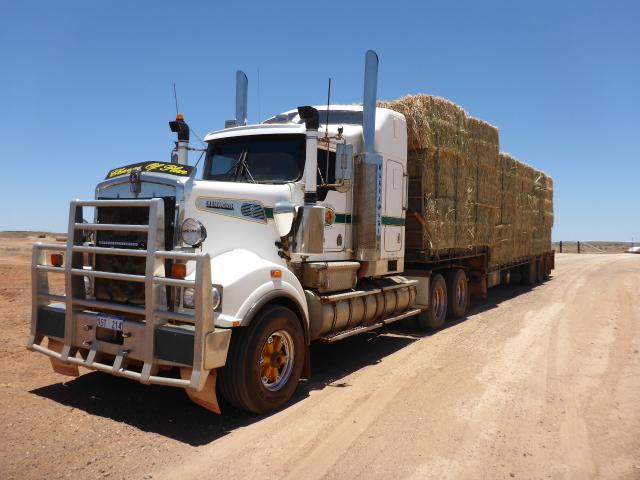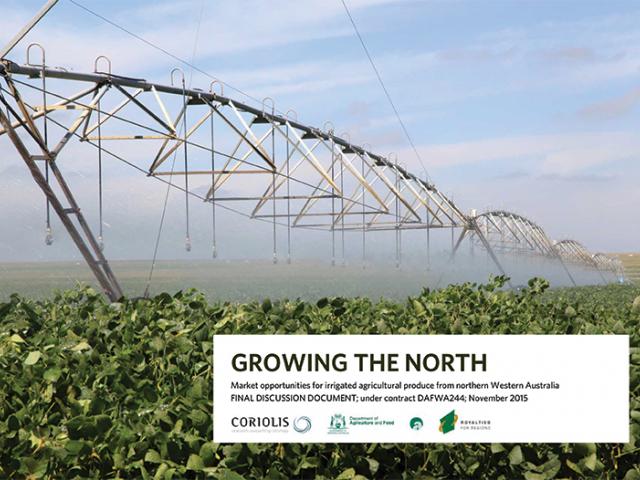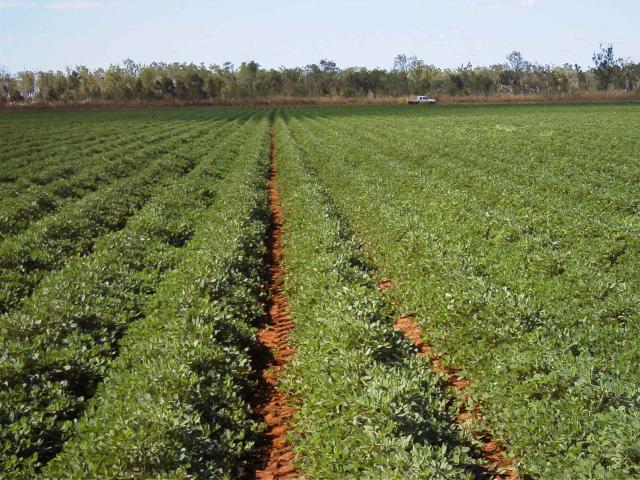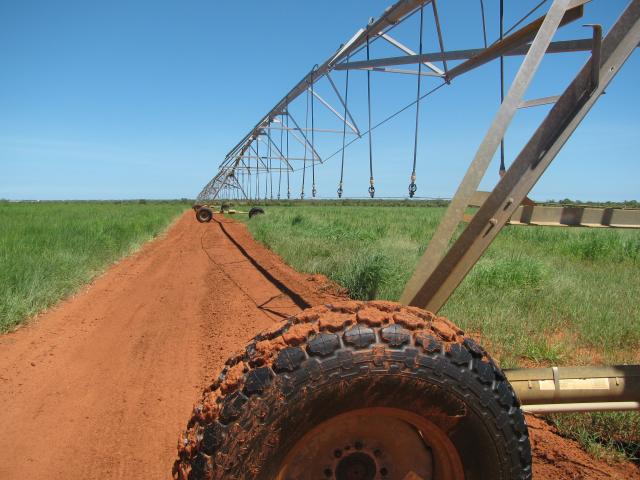
Project Manager's update
The Pilbara Hinterland Agricultural Development Initiative (PHADI) team have had some encouraging achievements since our last update.
We held our second project update session in November, where we showcased findings from a number of the diverse areas of research which make up the PHADI project.
Our hydrologist John Simons has created a map of all known licenced water resources in the Pilbara, including mine dewater, which could be used for irrigation development. It highlighted that although there is little remaining licensable allocation, there are many unproven resources. This is where John will now be directing his focus.
Considerable understanding of market opportunities and the economics of undertaking irrigated agriculture in the Pilbara has been gained through two pieces of work we commissioned to Coriolis Research and GHD respectively. This work allowed us to intensify our focus on investigating a subset of irrigated agriculture enterprises that are more likely to have a viable fit in the Pilbara.
At the time of publication, DAFWA was notified that mining operations at the Woodie Woodie manganese mine would be suspended and the mine put on care and maintenance from 2 February 2016.
The PHADI team is assessing the full impact of the closure on its Woodie Woodie trial sites of irrigated agricultural crops, which include sorghum, perennial grasses, lucerne and tropical legumes. We are working with our project partners to investigate options to maintain access to water to allow for the continuation of the project.
DAFWA and our PHADI project partners have had a close working relationship with mine owner and operator, Consolidated Minerals throughout the development and commissioning of the Woodie Woodie project.
The change in mining operations highlights a key learning of the irrigation project. This inherent risk of using mine dewater demonstrates the importance of security of water supply for irrigated agriculture.
2016 is shaping up to be a pivotal year for the PHADI project as our resource investigations, economic and regulatory framework studies start to coalesce to give a vision of not only where Pilbara irrigation opportunities may exist, but the steps needed to bring them to fruition.
Find out more
We welcome your feedback on any of the featured articles in this edition or questions about the project.
Visit the PHADI webpage or email the team; phadi@agric.wa.gov.au
Find us on Twitter by following @DAF_WA, and keep an eye out for #PHADI for our latest project updates
The Pilbara Hinterland Agricultural Development Initiative is made possible by the State Government’s Royalties for Regions program.
Making hay – first harvest marks milestone for irrigation project in eastern Pilbara
Crops at the remote Woodie Woodie trial site have been harvested for the first time, as part of a pioneering project testing the use of surplus mine dewater to for irrigated agriculture.
Sorghum, Rhodes grass, lab lab and millet have been cut, baled and made into hay 10 weeks after planting.
The 38 hectare Woodie Woodie trial site is located on Warrawagine station, 190 kilometres east of Marble Bar.
The site was sown to sorghum, Rhodes grass and lucerne, as well as legumes including, Cavalcade and burgundy beans.
A 350 metre centre pivot irrigates the trials, using surplus mine dewater discharged from the Woodie Woodie manganese mine, 10 kilometres away.
The system’s ‘taps’ were officially turned on in September last year, after which plantings commenced.
PHADI Project Manager Chris Schelfhout said the trials would be used to evaluate the agronomic and economic potential in the Pilbara’s extreme heat.
“An initial analysis shows the hay is of average quality. However, this was to be expected given the fast growing environment of the Pilbara in summer,” Chris said.
“We’ve learnt a significant amount about matching crop nutrient to growth expectations, which we can apply before the next cut of the crops.”
“We would expect to get another two cuts off the crop before the season ends in autumn.”
“Further examination of yields and quality of all crops will be undertaken of subsequent harvests as the project progresses.”
The hay has been fed to the Droughtmaster cattle on Warrawagine station, which is owned by the Mills family.
Chris said he believed this was the first time a thorough, quantitative study of irrigated pastoral crops had been undertaken.
“The aim is to capture information about crop production, as well as the nutritional composition and crop physiology during the calendar year,” he said.
“That will provide information from which an economic analysis of stand-alone crop production and potential benefit in livestock feeding systems can be developed.”
“Ultimately we hope to identify a suite of species that are suitable for cattle feeding systems or biofuel production that perform well in this environment,” he said.
“Market research will also explore the domestic and export opportunities for these and other irrigated crops.”
Woodie Woodie weed risk nursery and agronomy trials
The Northern Beef Futures (NBF) Mosaic Agriculture team are developing weed risk assessment processes and exploring opportunities for irrigated and dryland forage systems to transform northern beef production systems as part of the Royalties for Regions NBF project, led by the Department of Agriculture and Food, WA (DAFWA).
Weed risk field nurseries
Most of northern WA is under pastoral lease and to grow non-indigenous (exotic) plants requires a diversification permit from the Pastoral Lands Board (PLB).
As part of the approval process the PLB seeks advice on the potential ‘weediness’ of the proposed species from DAFWA and the Department of Parks and Wildlife (DPaW). The NBF Mosaic Agriculture project is developing a weed risk assessment that takes account of the context (i.e. site and surrounding land systems). At present the weed risk assessment is a desktop analysis, so the team are busy gathering data from ‘old’ trial sites and some new, innovative field nurseries.
A series of field nurseries have been established to obtain data on the persistence and/or spread of a wide range of pasture and fodder grasses and legumes.
Three sites have been established: (i) Birdwood Downs (near Derby), (ii) Wades Bore on Wallal Downs Station (Eighty Mile Beach) and (iii) at Woodie Woodie (200km east of Marble Bar), with a fourth site proposed for Gogo Station (near Fitzroy Crossing) early this year.
The field nursery trials are under irrigation to simulate the worst case scenario, i.e. if plants establish and set seed following a tropical cyclone or an extremely high rainfall year. The irrigation will gradually be turned off over the coming wet season, when the plants are well established.
At each site there are two replicated trials. The ‘grass’ trials have 23 entries that include a range of warm season (C4) annual and perennial grasses such as Rhodes grass, panic grass, buffel grass and a selection of sorghums and millets. Each entry has plus and minus (+/-) fertilizer sub-treatments and each combination is replicated three times.
The ‘legume’ trials have 23 entries and include tropical legumes like lablab, cowpea, siratro and butterfly pea, a range of stylos and the fodder shrub leucaena. The only temperate legume is lucerne. Each entry has plus and minus fertilizer, and plus and minus rhizobia sub-treatments where each combination is replicated three times. Each grass or legume plot consists of a single 3m row under trickle irrigation. In terms of weed risk, the ‘rubber hits the road’ this year when the irrigation is turned off.
We've already made some interesting findings:
- Lablab and cowpea were the standout legumes at both Derby and Wallal sites over ‘winter’, while the growth of the other legumes was generally very slow
- Large termites (Mastotermes spp.) have hollowed out the taproot of some leucaena seedlings at Wallal Downs resulting in the death of plants. More recently we have observed mud tunnels and termites on leucaena stems.
- Most of the legumes were preferentially grazed by wallabies at the Derby site, the exception being lablab and cowpea. In the end we had to put chicken wire over the supposedly wallaby-proof ringlock fence to keep the wallabies out.
- All of the warm season (C4) annual grasses had excellent early vigour. The perennial grasses generally had much lower seedling vigour with the exception of Buffel grass (Cenchrus ciliaris).
Woodie Woodie agronomy trials
The NBF Mosaic Agriculture team established a series of replicated small-plot trials under the research pivot at Woodie Woodie on Warrawagine Station, in collaboration with the PHADI team in September2015.
There are three replicated small plot trials: (i) warm season (C4) annual grasses (range of sorghums, millets, maize); (ii) a range of warm season (C4) perennial grasses and (iii) a range of tropical legumes and lucerne.
The annual grasses have established well and the first biomass measurements were taken in late November 2015 on the annual and perennial grass trials. Some plots in the legume trial were adversely affected by strong winds/sand blasting and were reseeded in November 2015.

Report focuses on growing northern Western Australia
Growing demand for safe, high quality food in Asia and the Middle East is creating a unique opportunity for the agricultural sector of the north.
The Department of Agriculture and Food, WA (DAFWA) commissioned Growing the north – market opportunities for irrigated agricultural produce from Northern Western Australia to identify high-potential products which suit northern production conditions and export markets with high-growth potential.
The publication will help businesses, industry and investors identify the best market opportunities for irrigated agricultural produce in northern WA.
Growing the north takes a market-led approach, rather than a production focus, to target growing export markets and identify products with strong demand.
Eighteen high-potential products have been identified as opportunities for irrigated agriculture in northern WA, ranging from walnuts and lucerne hay to cotton and sorghum.
A three-stage screening process was used to understand which products WA’s key target markets want, that could be competitively produced in northern WA.
It identifies agricultural products grown using irrigation, in countries regarded as ‘climatic peers’ of northern WA and connects these with significant demand in growth-markets and countries.
The report aims to stimulate thinking and discussion about potential opportunities for irrigated agricultural product from northern WA. The next step is to assess the commercial viability of the high-potential products in the context of our northern environment.
Growing the north was a collaboration across three Royalties for Regions projects led by DAFWA, including PHADI (Pilbara), Gascoyne Food Bowl (Gascoyne) and La Grange (Kimberley).
Find the full report here.

Economic analysis of irrigated agriculture development options
A new desktop study has identified the viability of growing a range of irrigated fodder and horticulture crops, and associated value-added developments in the Pilbara.
The Economic analysis of irrigated agriculture development options for the Pilbara was commissioned by the Department of Agriculture and Food WA (DAFWA), as part of the $12.5 million Pilbara Hinterland Agricultural Development Initiative (PHADI).
The report modelled a number of crop production scenarios, staged development and value-added options, to compare returns over a 30 year timeframe.
Lucerne hay, Rhodes grass hay, cotton, peanuts and sweet potatoes showed positive returns based on a $10,000 per hectare development cost.
While value-added canning tomatoes achieved a positive return, the cost of vegetable processing was greater than any additional benefit.
The report also indicated that a 10,000 head feedlot of cattle trucked to Perth could yield a positive scenario, while a biofuel plant based on 800 hectares of sorghum broke even at $1.18 per litre.
DAFWA Economist and PHADI team member, Brad Plunkett, said the level of development cost was a critical factor in assessing a crop’s potential economic viability.
"A staged approach to irrigated development was preferable," he said.
“The expansion of fodder crops in the immediate term, which complement the existing pastoral industry, is a good model of initial development."
"As soil and water resource bases are established and production systems are refined, additional opportunities can be pursued, such as those suggested by the DAFWA's recently released Growing the North report."
To create viable, long term business opportunities further attention needs to be paid to infrastructure needs, and linking production to market and investment opportunities in fast-growing, high-value markets.
The report provides an overview of the break-even cost for a range of irrigated crops, including fodder (grain and hay), fibre (cotton), human food (pulses, peanuts, tomatoes and capsicums) and industrial use (sorghum for biofuels), as well the minimum scale required for selected developments to be viable.
The information from the report will be integrated into new analytical tools, currently under construction, to assist irrigated agricultural development in the Pilbara, and address the site-specific nature of development opportunities.
The PHADI team are working with project partners to ground truth the report’s yield assumptions, and will be integrated into the project’s prefeasibility study on the potential for irrigated agriculture development in the Pilbara which will be published at the completion of the PHADI project in 2017.

Water for Food - Land Tenure Pathway Project
In August 2015, the State Government announced the process for land tenure changes which will stimulate economic development and investment in irrigated agriculture projects across Western Australia.
The Land Tenure Pathway for Irrigated Agriculture (LTPIA) project is led by the Department of Lands and is part of the State Government's $40 million Water for Food program.. The LTPIA will help pastoralists and third party investors obtain more secure land tenure to develop irrigated agricultural projects.
The Department of Lands (DoL) is working closely with Department of Water (Dow) on six projects under Water for Food West Kimberley and Water for Food Part 2, including: Mowanjum pastoral lease irrigation trial; Knowsley Agricultural Area water investigation; Fitzroy Valley groundwater investigation; La Grange – West Canning Basin: groundwater for growing opportunities; Bonaparte Plains: Ord East Kimberley expansion and the LTPIA project.
The LTPIA project team is working with DoW and the Department of Agriculture and Food WA (DAFWA) to provide Crown land administration expertise and strategy for Water for Food projects. DoL is also engaging with DAFWA’s La Grange and the Pilbara Hinterland Agriculture Development Initiative (PHADI) projectand also has representation on the steering committee.
A staged approach is being undertaken with the LTPIA project, starting with consultation, development and approval of policy principles. Project milestones include the development of policy principles, a policy framework and information packages.
DoL deals with change of tenure of Crown land in everyday business. This project has defined a specific land tenure pathway, using policy principles as a foundation, which has been endorsed by Cabinet. This “gateway” approach will apply to proposals for irrigated agriculture that are proponent-led and at the proponents’ cost.
Securing higher land tenure, such as leasehold or freehold is critical for the program to be successful in enabling development of irrigated agriculture and provides an opportunity to existing interest holders to obtain more security to attract investment as well as allow diversification of the pastoral industry and other Crown land.
A substantial amount of work is currently going into documenting the tenure change process which will form part of the information packages which will assist proponents to change tenure over a portion of a pastoral lease or other Crown land.
The team is working with relevant Government agencies which provide statutory approvals to ensure synergies are identified to enhance the quality of the information being developed for potential proponents.
Traditional Owners will have the right to negotiate the terms of the surrender of their native title rights, as Indigenous Land Use Agreements (ILUAs) between the proponent and native title parties are one of the conditions for proceeding to formal tenure. The State will be a party to these agreements; however it will not be involved in compensation or negotiation.
Template ILUAs, guidelines on their negotiation and registration, along with general application guidelines for those following the LTPIA, are being developed to assist proponents in understanding the opportunities, risks, timeframes, and costs associated. The application guideline will be a cross-agency initiative that will include not only DoL requirements but also those of other state agencies for irrigated agriculture development. The aim is that the proponent will have one point of reference.
Consultation is also ongoing with Native Title holders, pastoralists, local governments and many other stakeholders who have an interest in a higher form of tenure to support further irrigated agricultural development.
To find out more, visit the Department of Lands website or email waterforfood@lands.wa.gov.au

Tapping into the Pilbara's water resource data
For the past 12 months, Department of Agriculture and Food WA (DAFWA) Research Officer John Simons has been inundated in data to produce the first audit of water resources for irrigated agriculture development in the Pilbara.
The pioneering research is part of the Royalties for Regions Pilbara Hinterland Agricultural Development Initiative (PHADI) DAFWA leads, which aims to unlock critical information about the potential of irrigated agricultural development in the Pilbara.
Mr Simons said the audit is a component of the agricultural resource assessment of the region, and encompasses data on groundwater, mine dewater surplus, and surface water potentially available to support irrigated agriculture in the region.
“We’ve gone from a blank canvas to now having a much clearer picture of the location, quantity and quality of water resources in the Pilbara for irrigated agriculture, which previously didn’t exist.”
“We kicked off the audit in September 2014 and since that time, I’ve reviewed more than 100 water resource reports and papers,” Mr Simons said.
“Some of the water resource information is highly sensitive, particularly mine dewater volumes, so we had to work closely with our project collaborators to get access to some of the ‘restricted’ (commercial in confidence) reports,” John said.
“The oldest report I’ve sited is from 1964, from the WA State Reference Collection.”
“Specifically, we’ve looked at what volume of water is available in areas that have allocation limits; which mines have surplus dewater that isn’t already consumed for mining activities or environmental purposes; what other sources of water are potentially available including untapped, non-targeted aquifers, and surface water that could be captured and stored through Managed aquifer recharge (MAR) systems.”
Close to 45 gigalitres per annum of water is currently licenced for irrigated agriculture in the Pilbara and this is proposed to double within the next two years, to more than 100GL/a.
John says there is further potential for irrigated agricultural development using mine dewater surplus and surface water, through the use of MAR systems similar to the Ophthalmia dam near Newman.
“The review continues as new reports are produced, such as water licence and environmental reports for new mines and mine expansions.”
The audit results (excluding commercial in confidence data) will be compiled into a chapter of the PHADI prefeasibility report and made available on DAFWA’s website, as part of a suite of information products produced by the PHADI project.
